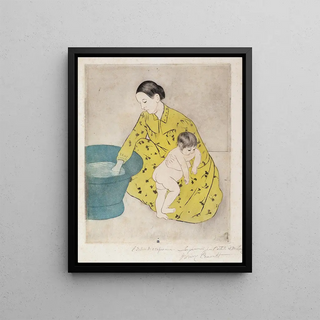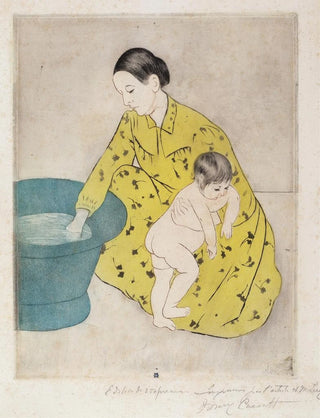Art print | The bath - Mary Cassatt


View from behind

Frame (optional)
The artwork "Le bain" by Mary Cassatt is a true immersion into the intimacy and delicacy of everyday life. Painted at the end of the 19th century, this canvas evokes a fleeting, almost ephemeral moment where maternal tenderness blends with the softness of simple gestures. Cassatt, an iconic figure of the Impressionist movement, manages to capture the essence of femininity through this domestic scene, where mother and child share a moment of complicity. The artist, by focusing on the feminine universe, offers a unique perspective on human relationships while celebrating the beauty of ordinary life.
Style and uniqueness of the artwork
In "Le bain," Cassatt uses soft colors and delicate brushstrokes that infuse a calming atmosphere into the composition. The harmony of pastel shades, combined with natural light, creates a serene, almost contemplative ambiance. The figures, although stylized, convey an expressiveness that reflects the affection between mother and child. The staging, both intimate and universal, invites the viewer to feel the warmth of this shared moment. The composition is carefully balanced, with each element arranged to guide the eye toward the heart of the scene. This artistic choice reflects Cassatt's mastery of perspective and light, elements that have become signatures of her style.
The artist and her influence
Mary Cassatt, born in 1844, is often regarded as one of the greatest American artists of her time. As a female painter in a male-dominated world, she succeeded in establishing herself through her talent and vision. Her friendship with Edgar Degas, another pillar of Impressionism, had a significant impact on her work, allowing her to explore themes related to women's lives and motherhood. Cassatt also played a crucial role in promoting Impressionist art in the United States, paving the way for many female artists. Her innovative approach and her ability to capture moments of tenderness and vulnerability have left a mark on art history, influencing generations of artists worldwide.
A wall decoration

Matte finish

View from behind

Frame (optional)
The artwork "Le bain" by Mary Cassatt is a true immersion into the intimacy and delicacy of everyday life. Painted at the end of the 19th century, this canvas evokes a fleeting, almost ephemeral moment where maternal tenderness blends with the softness of simple gestures. Cassatt, an iconic figure of the Impressionist movement, manages to capture the essence of femininity through this domestic scene, where mother and child share a moment of complicity. The artist, by focusing on the feminine universe, offers a unique perspective on human relationships while celebrating the beauty of ordinary life.
Style and uniqueness of the artwork
In "Le bain," Cassatt uses soft colors and delicate brushstrokes that infuse a calming atmosphere into the composition. The harmony of pastel shades, combined with natural light, creates a serene, almost contemplative ambiance. The figures, although stylized, convey an expressiveness that reflects the affection between mother and child. The staging, both intimate and universal, invites the viewer to feel the warmth of this shared moment. The composition is carefully balanced, with each element arranged to guide the eye toward the heart of the scene. This artistic choice reflects Cassatt's mastery of perspective and light, elements that have become signatures of her style.
The artist and her influence
Mary Cassatt, born in 1844, is often regarded as one of the greatest American artists of her time. As a female painter in a male-dominated world, she succeeded in establishing herself through her talent and vision. Her friendship with Edgar Degas, another pillar of Impressionism, had a significant impact on her work, allowing her to explore themes related to women's lives and motherhood. Cassatt also played a crucial role in promoting Impressionist art in the United States, paving the way for many female artists. Her innovative approach and her ability to capture moments of tenderness and vulnerability have left a mark on art history, influencing generations of artists worldwide.
A wall decoration






